The Variation in the Water Level of Lake Baikal and Its Relationship with the Inflow and Outflow
Abstract
1. Introduction
2. Materials and Methods
2.1. Object of Study
2.2. Input Data
2.3. Methods of Adjusting the Regulated Levels of Lake Baikal and the Angara Runoff to Natural Conditions
2.4. Methods for Analyzing Multi-Year Changes
3. Results and Discussion
3.1. Reconstruction of Multi-Year Time Series for the Water Level of Lake Baikal and Outflow from the Lake through the Angara River
3.1.1. Reconstructed Monthly and Annual Lake Levels
3.1.2. Water Discharge of the Angara River
3.2. Characterization of Multi-Year Level Fluctuations for 1898–2020 by Natural and Conditionally Natural Values
3.3. Patterns of Multi-Year Changes in Conditionally Natural Annual and Seasonal Levels of Lake Baikal
3.4. Perennial Variation in Annual and Seasonal Water Discharge of the Angara River and the Three Main Tributaries of Lake Baikal
3.4.1. Multi-Year Variability
3.4.2. Long-Term Phases of Annual and Seasonal Water Discharge of the Angara River and Total Water Discharge of the Three Main Tributaries of Lake Baikal
3.5. Coupling of Long-Term Phases of Changes in the Lake Baikal Water Level and Discharge of the Angara River and the Lake Baikal Tributaries
3.6. The Influence of Lake Baikal on Multi-Year Changes in the Intra-Annual Structure of the Angara River Runoff
3.7. Impact of the Irkutsk HPP on the Intra-Annual Distribution of the Level of Lake Baikal and the Angara Discharge
3.7.1. The Water Levels of Lake Baikal
3.7.2. Angara Water Discharge at the Irkutsk HPP and at Pashki
4. Conclusions
Author Contributions
Funding
Data Availability Statement
Acknowledgments
Conflicts of Interest
Appendix A
| Long Phase | River Water Discharge/Baikal Lake Water Level, Averaged for: | ||
|---|---|---|---|
| Whole Year (January–December) | Warm Season (May–October) | Cold Season (November–April) | |
| Three river tributaries of Baikal Lake (Selenga, Barguzin, and Upper Angara) | |||
| D | 1973–1981/1150 1995–2016/1123 | 1973–1981/1997 1995–2016/1863 | 1940–1960/318 1975–1984/297 2003–2012/350 |
| Daverage | 1137 | 1930 | 322 |
| I | 1958–1972/1353 | 1958–1972/2353 | 1985–2002/412 |
| 1982–1994/1470 | 1982–1994/2540 | 2013–2020/442 | |
| Iaverage | 1412 | 2447 | 427 |
| Iaverage–Daverage, m3/s | 275 | 517 | 105 |
| Iaverage–Daverage, in % relative to Daverage | 24/2 | 26/8 | 32/5 |
| Phase when mean water discharge is close to discharge for the entire period of observations | - | - | 1961–1974/367 |
| Mean water discharge for the entire period of observations | 1272 | 2178 | 362 |
| Angara River at Pashki and/or at the Irkutsk HPP | |||
| D | 1899–1929/1790 | 1899–1929/2039 | 1900–1929/1552 |
| I | 1930–1942/2286 | 1930–1942/2608 | 1930–1942/1948 |
| 1949–1975/2063 | 1949–1975/2332 | 1949–1975/1797 | |
| 1983–2014/2169 | 1983–2014/2433 | 1983–2014/1911 | |
| Iaverage | 2173 | 2458 | 1885 |
| Iaverage–D, m3/s | 383 | 419 | 333 |
| Iaverage–D, in % relative to D | 21/4 | 20/5 | 21/5 |
| Mean water discharge for the entire period of observations | 2010 | 2271 | 1749 |
| Baikal Lake | |||
| D | 1899–1929/455.54 | 1899–1929/455.68 | 1900–1929/40 |
| I | 1930–1942/455.80 | 1930–1942/455.96 | 1930–1942/455.63 |
| 1949–1975/455.69 | 1949–1975/455.83 | 1949–1975/455.55 | |
| 1983–2014/455.75 | 1983–2014/455.89 | 1983–2014/455.62 | |
| Iaverage | 455.75 | 455.89 | 455.60 |
| Iaverage–D, m | 20.55 | 21.43 | 20.36 |
| Mean water level for the 1898–2020 period | 455.66 | 455.80 | 455.52 |
References
- Sinha, E.; Michalak, A.M.; Balaji, V. Eutrophication will increase during the 21st century as a result of precipitation changes. Science 2017, 357, 405–408. [Google Scholar] [CrossRef]
- Zoljoodi, M.; Didevarasl, A. Water-Level Fluctuations of Urmia Lake: Relationship with the Long-Term Changes of Meteorological Variables (Solutions for Water-Crisis Management in Urmia Lake Basin). Atmos. Clim. Sci. 2014, 4, 358–368. [Google Scholar] [CrossRef][Green Version]
- Tao, S.; Fang, J.; Zhao, X.; Zhao, S.; Shen, H.; Hu, H.; Tang, Z.; Wang, Z.; Guo, Q. Rapid loss of lakes on the Mongolian Plateau. Proc. Natl. Acad. Sci. USA 2015, 112, 2281–2286. [Google Scholar] [CrossRef]
- Filatov, N.N.; Viruchalkina, T.Y.; Dianskiy, N.A.; Nazarova, L.E.; Sinukovich, V.N. Variability in the level of the largest lakes of Russia. Dokl. Earth Sci. 2016, 467, 393–397. [Google Scholar] [CrossRef]
- Chen, J.L.; Pekker, T.; Wilson, C.R.; Tapley, B.D.; Kostianoy, A.G.; Cretaux, J.; Safarov, E.S. Long-term Caspian Sea level change. Geophys. Res. Lett. 2017, 44, 6993–7001. [Google Scholar] [CrossRef]
- Wurtsbaugh, W.A.; Miller, C.; Null, S.E.; DeRose, R.J.; Wilcock, P.; Hahnenberger, M.; Howe, F.; Moore, J. Decline of the world’s saline lakes. Nat. Geosci. 2017, 10, 816–821. [Google Scholar] [CrossRef]
- Dorjsuren, B.; Yan, D.; Wang, H.; Chonokhuu, S.; Enkhbold, A.; Davaasuren, D.; Girma, A.; Abiyu, A.; Jing, L.; Gedefaw, M. Observed trends of climate and land cover changes in Lake Baikal basin. Environ. Earth Sci. 2018, 77, 725. [Google Scholar] [CrossRef]
- Dorjsuren, B.; Yan, D.; Wang, H.; Chonokhuu, S.; Enkhbold, A.; Xu, Y.; Girma, A.; Gedefaw, M.; Abiyu, A. Observed Trends of Climate and River Discharge in Mongolia’s Selenga Sub-Basin of the Lake Baikal Basin. Water 2018, 10, 1436. [Google Scholar] [CrossRef]
- Zou, Z.; Xiao, X.; Dong, J.; Qin, Y.; Doughty, R.B.; Menarguez, M.A.; Zhang, G.; Wang, J. Divergent trends of open-surface water body area in the contiguous United States from 1984 to 2016. Proc. Natl. Acad. Sci. USA 2018, 115, 3810–3815. [Google Scholar] [CrossRef]
- Zhao, G.; Li, Y.; Zhou, L.; Gao, H. Evaporative water loss of 1.42 million global lakes. Nat. Commun. 2022, 13, 3686. [Google Scholar] [CrossRef]
- Foroumandi, E.; Sameh, V.; Kantoush, A. Investigating the main reasons for the tragedy of large saline lakes: Drought, climate change, or anthropogenic activities? A call to action. J. Arid Environ. 2022, 196, 104652. [Google Scholar] [CrossRef]
- Chaudhari, S.; Felfelani, F.; Shin, S.; Pokhrel, Y. Climate and anthropogenic contributions to the desiccation of the second largest saline lake in the twentieth century. J. Hydrol. 2018, 560, 342–353. [Google Scholar] [CrossRef]
- Foroumandi, E.; Nourani, V.; Sharghi, E. Climate change or regional human impacts? Remote sensing tools, artificial neural networks, and wavelet approaches aim to solve the problem. Hydrol. Res. 2021, 52, 176–195. [Google Scholar] [CrossRef]
- Fangfang, Y.; Livneh, B.; Rajagopalan, B.; Wang, J.; Crétaux, J.-F.; Wada, Y.; Berge-Nguyen, M. Satellites reveal widespread decline in global lake water storage. Science 2023, 380, 743–749. [Google Scholar] [CrossRef]
- Williamson, C.E.; Saros, J.E.; Vincent, W.F.; Smol, J.P. Lakes and reservoirs as sentinels, integrators, and regulators of climate change. Limnol. Oceanogr. 2009, 54, 2273–2282. [Google Scholar] [CrossRef]
- Ye, X.; Liu, F.; Zhang, Z.; Xu, C. Quantifying the Impact of Compounding Influencing Factors to the Water Level Decline of China’s Largest Freshwater Lake. J. Water Resour. Plan. Manag. 2020, 146, 05020006. [Google Scholar] [CrossRef]
- Shiklomanov, I.A. Hydrological Aspects of the Caspian Sea Problem; Hydrometeoizdat: Leningrad, Russia, 1976; 73p. (In Russian) [Google Scholar]
- Micklin, P.; Aladin, N.V.; Plotnikov, I. The Aral Sea: The Devastation and Partial Rehabilitation of a Great Lake, 2014th ed.; Springer Earth System Sciences Book; Springer: Berlin/Heidelberg, Germany, 2014; Volume 10178. [Google Scholar]
- Moore, M.V.; Hampton, S.E.; Izmesteva, L.R.; Silow, E.A.; Peshkova, E.V.; Pavlov, B.K. Climate Change and the World’s “Sacred Sea”—Lake Baikal, Siberia. BioScience 2009, 59, 405–417. [Google Scholar] [CrossRef]
- Groisman, P.Y.; Shugart, H.H.; Kicklighter, D.; Henebry, G.; Tchebakova, N.; Maksyutov, S.; Monier, E.; Gutman, G.; Gulev, S.; Qi, J.; et al. Northern Eurasia Future Initiative (NEFI): Facing the challenges and pathways of global change in the twenty-first century. Prog. Earth Planet. Sci. 2017, 4, 41. [Google Scholar] [CrossRef]
- Shimaraev, M.N.; Kuimova, L.N.; Sinyukovich, V.N.; Zechanovcki, V.V. Climate and hydrological processes in Lake Baikal in the 20th century. Russ. Meteorol. Hydrol. 2002, 3, 52–58. [Google Scholar]
- Shimaraev, M.N.; Starygina, L.N. Zonal atmospheric circulation, climate, and hydrological processes at Baikal Lake (1968–2007). Geogr. Nat. Resour. 2010, 3, 245–250. [Google Scholar] [CrossRef]
- Third Assessment Report of Climate Change and Its Impacts on the Territory of the Russian Federation; High Technology Publ., Roshydromet: St. Peterburg, Russia, 2022; p. 676. (In Russian)
- Kouraev, A.V.; Semovski, S.V.; Shimaraev, M.N.; Mognard, N.M.; Legresy, B.; Remy, F. The ice regime of Lake Baikal from historical and satellite data: Relation to air temperature, dynamical, and other factors. Limnol. Oceanogr. 2007, 52, 1268–1286. [Google Scholar] [CrossRef]
- Goldman, C.R.; Kumagai, M.; Robats, R.D. (Eds.) Climatic Change and Warming of Inland Waters: Impacts and Mitigation for Ecosystems and Societies; John Wiley & Sons, Ltd. Publications: Hoboken, NJ, USA, 2013; p. 472. [Google Scholar] [CrossRef]
- Sinyukovich, V.N.; Sizova, L.N.; Shimaraev, M.N.; Kurbatova, N.N. Characteristics of current changes in water inflow into Lake. Geogr. Nat. Resour. 2013, 4, 350–355. [Google Scholar] [CrossRef]
- Tundisi, J.G.; Tundisi, T.M. Limnology; CRC Press: Boca Raton, FL, USA, 2011; p. 888. [Google Scholar] [CrossRef]
- Vuglinsky, V.S.; Kuznetsova, M.R. The World’s Largest Lakes Water Level Changes in the Context of Global Warming. Nat. Resour. 2019, 10, 29–46. [Google Scholar] [CrossRef]
- International Data Centre on Hydrology of Lakes and Reservoirs. Available online: http://www.hydrolare.net (accessed on 15 December 2023).
- Georgiadi, A.G.; Kashutina, E.A.; Milyukova, I.P. Long-term changes of water flow, water temperature and heat flux of the largest Siberian rivers. Polarforschung 2018, 87, 167–176. [Google Scholar] [CrossRef]
- Georgiadi, A.G.; Groisman, P.Y. Long-term changes of water flow, water temperature and heat flux of two largest arctic rivers of European Russia, Northern Dvina and Pechora. Environ. Res. Lett. 2022, 17, 085002. [Google Scholar] [CrossRef]
- Georgiadi, A.G.; Groisman, P.Y. Extreme Low Flow during Long-Lasting Phases of River Runoff in the Central Part of the East European Plain. Water 2023, 15, 2146. [Google Scholar] [CrossRef]
- Nikitin, V.M.; Bychkov, I.V.; Abasov, N.V.; Osipchuk, E.N. Level regime of Lake Baikal: Problems and contradictions. Geogr. Nat. Resour. 2019, 4, 74–83. [Google Scholar] [CrossRef]
- Sinyukovich, V.N.; Chernyshov, M.S. Water regime of Lake Baikal under conditions of climate change and anthropogenic influence. Quat. Int. 2019, 524, 93–101. [Google Scholar] [CrossRef]
- Timoshkin, O.A.; Malnik, V.V.; Sakirko, M.V.; Boedeker, K. Environmental crisis at Lake Baikal: Scientists diagnose. Sci. First Hand 2014, 5, 75–91. [Google Scholar]
- Timoshkin, O.A.; Samsonov, D.P.; Yamamuro, M.; Moore, M.V.; Belykh, O.I.; Malnik, V.V.; Sakirko, M.V.; Shirokaya, A.A.; Bondarenko, N.A.; Domysheva, V.M.; et al. Rapid ecological change in the coastal zone of Lake Baikal (East Siberia): Is the site of the world’s greatest freshwater biodiversity in danger? J. Great Lakes Res. 2016, 42, 487–497. [Google Scholar] [CrossRef]
- Russian Government. About Limit Values of Water Level in Lake Baikal at Implementation of Economic and Other Activity: The Order of the Government of the Russian Federation 26.03.2001. № 234; Collection of Legislation of the Russian Federation; Russian Government: Moscow, Russia, 2001; Volume 14, p. 1366. (In Russian)
- Sinyukovich, V.N. Recovery of the natural level regime of Lake Baikal after construction of the Irkutsk hydroelectric power plant. Russ. Meteorol. Hydrol. 2005, 7, 47–51. [Google Scholar]
- International Lake Ontario–St. Lawrence River Study Board. Options for Managing Lake Ontario and St. Lawrence River Water Levels and Flows: Final Report to the International Joint Commission. Available online: https://ijc.org/en/loslrb (accessed on 15 December 2023).
- Afanasiev, A.N. Water Budget of Lake Baikal. In Studies of the Hydrological Regime of Lake Baikal; Publ. of the Academy of Sciences of the USSR, Moscow-Leningrad Publ. House of the Academy of Sciences of the USSR: Moscow, Russia, 1960; pp. 155–241. (In Russian) [Google Scholar]
- Afanasiev, A.N. Fluctuations of Hydrometeorological Regime in USSR Territory; Nauka: Moscow, Russia, 1967; p. 230. (In Russian) [Google Scholar]
- Sinyukovich, V.N.; Chernyshov, M.S. Current Problems of the Water Level Control in Lake Baikal. Bull. Irkutsk. State Univ. Ser. Earth Sci. 2018, 24, 99–110. (In Russian) [Google Scholar] [CrossRef][Green Version]
- Irkutsk Hydroelectric Power Station on the Angara River; Technical Project. V. 1. Natural Conditions; The Moscow Branch of the Institute Gidroenergoproekt: Moscow, Russia, 1951; p. 220. (In Russian)
- Russian Government. Rules for the Use of Water Resources of the Irkutsk Reservoir and Lake Baikal; Publ. of the Moscow University of Environmental Engineering: Moscow, Russia, 2013; p. 168. (In Russian)
- Frolov, A.V.; Vyruchalkina, T.Y. Dynamic-stochastical modeling of long-term fluctuations in Lake Baykal levels and Angara River runoff. Water Res. 2017, 44, 380–389. [Google Scholar] [CrossRef]
- Andreyanov, V.G. Cyclical fluctuations of annual runoff and their accounting in hydrological calculations problems of runoff calculations. Proc. State Hydrol. Inst. 1959, 68, 3–50. (In Russian) [Google Scholar]
- Kundzewicz, Z.W.; Robson, A.J. Change detection in hydrological records—A review of the methodology/Revue méthodologique de la détection de changements dans les chroniques hydrologiques. Hydrol. Sci. J. 2004, 49, 7–19. [Google Scholar] [CrossRef]
- Shi, X.; Qin, T.; Nie, H.; Weng, B.; He, S. Changes in Major Global River Discharges Directed into the Ocean. Int. J. Environ. Res. Public Health 2019, 16, 1469. [Google Scholar] [CrossRef]
- Garcia, N.O.; Mechoso, C.R. Variability in the discharge of South American rivers and in climate/Variabilité des débits de rivières d’Amérique du Sud et du climat. Hydrol. Sci. J. 2005, 50, 478. [Google Scholar] [CrossRef]
- Zhang, Z.; Chen, X.; Xu Chong-Yu Yuan, L.; Yong, B.; Yan, S. Evaluating the non-stationary relationship between Precipitation and Streamflow in Nine Major Basins of China during the past 50 years. J. Hydrol. 2011, 409, 81–93. [Google Scholar] [CrossRef]
- Chiew, F.; Siriwardena, L. Trend/Change Detection Software. CRC for Catchment Hydrology, Australia. 2005. Available online: https://toolkit.ewater.org.au/Tools/TREND/documentation (accessed on 5 February 2024).
- Zhou, C.; van Nooijen, R.; Kolechkina, A.; Markus Hrachowitz, M. Comparative analysis of nonparametric change-point detectors commonly used in hydrology. Hydrol. Sci. J. 2019, 64, 1690–1710. [Google Scholar] [CrossRef]
- Stepanek, P.A. Clim-Software for Time Series Analysis. Department of Geography Fakulty of Sciences Masaric University Brno. 2008. Available online: https://en.freedownloadmanager.org/Windows-PC/AnClim.html (accessed on 5 February 2024).
- Pettitt, A.N. A non-parametric approach to the change-point problem. J. R. Statist. Soc. 1979, 28, 126–135. [Google Scholar] [CrossRef]
- Saveliev, V.A. Modern Problems and the Future of Hydropower in Siberia; Novosibirsk Science Publisher: Novosibirsk, Russia, 2000; p. 200. (In Russian) [Google Scholar]
- Abasov, N.V.; Bolgov, M.V.; Nikitin, V.M.; Osipchuk, E.N. Level regime regulation in Lake Baikal. Water Res. 2017, 44, 537–546. [Google Scholar] [CrossRef]
- Ministry of Land Reclamation and Water Resources of the Russian Federation. The Basic Rules for the Use of Water Resources in the Reservoir of the Angarsk Cascade of Hydroelectric Power Stations (Irkutsk, Bratsk and Ust-Ilimsk); RV-269-87: Approved by the order of the Minister of Land Reclamation and Water Resources of the RSFSR 30.11.1987; Minvodhoz of the Russian Federation: Moscow, Russia, 1988; 65p. (In Russian)
- Rybalsky, N.G.; Omelianenko, V.A. (Eds.) Water Resources and Water Management of Russia in 2018 (Statistical Handbook); NIA Priroda: Moscow, Russia, 2019; 274p. (In Russian) [Google Scholar]
- Mongolian Statistical Yearbook 2018. Mongolian Statistical Information Service, Ulaan Baatar, Mongolia, 2019; 612p. Available online: https://www.nso.mn/en (accessed on 5 February 2024).
- Adler, R.F.; Gu, G.; Sapiano, M.; Wang, J.-J.; Huffman, G.J. Global Precipitation: Means, Variations and Trends During the Satellite Era (1979–2014). Surv. Geophys. 2017, 38, 679–699. [Google Scholar] [CrossRef]
- Janney, D. Monitoring Freshwater Resources from Space. Earth Sci. 2021, 38, 16–18, 21-3 Fall TES WEB. [Google Scholar]

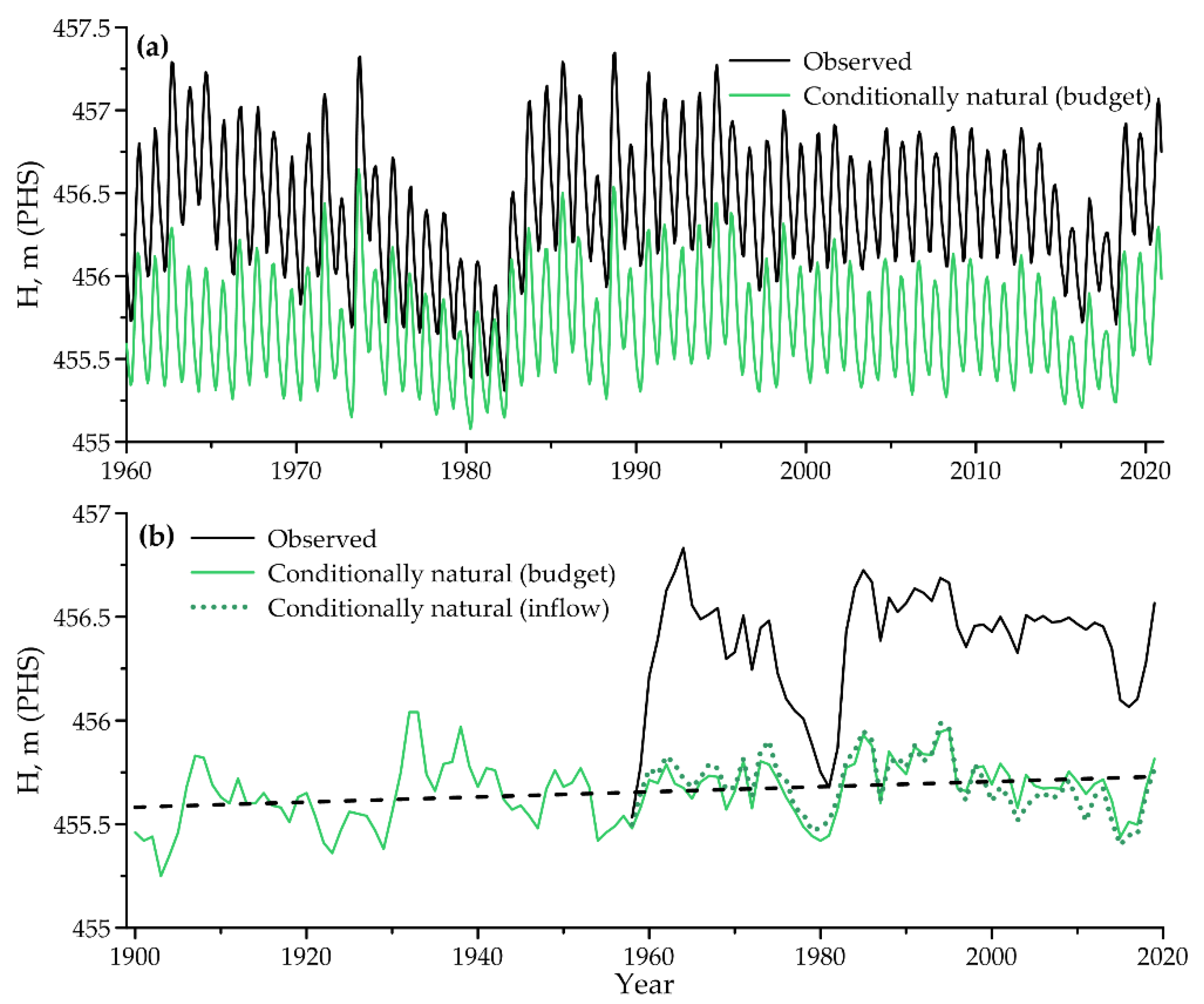

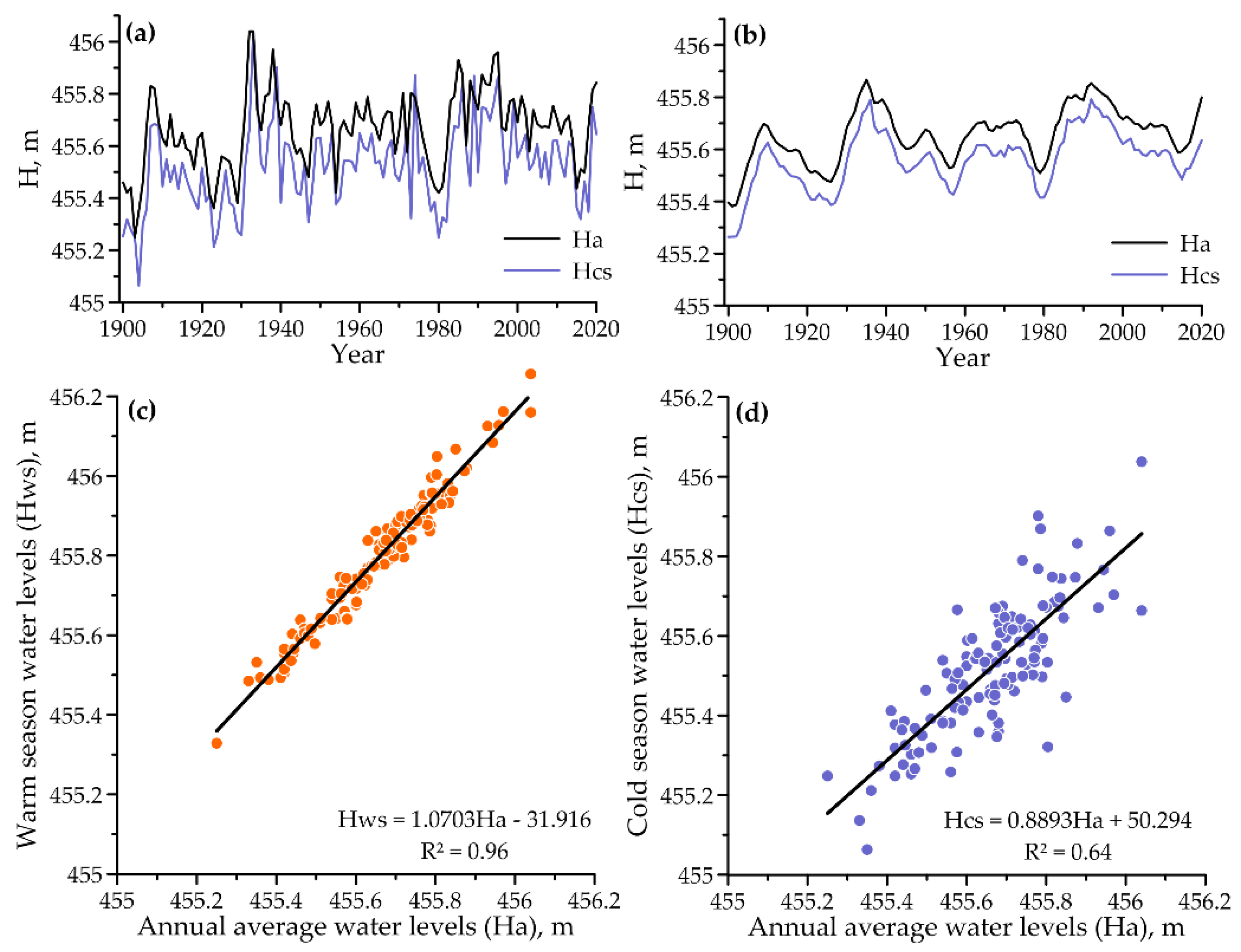
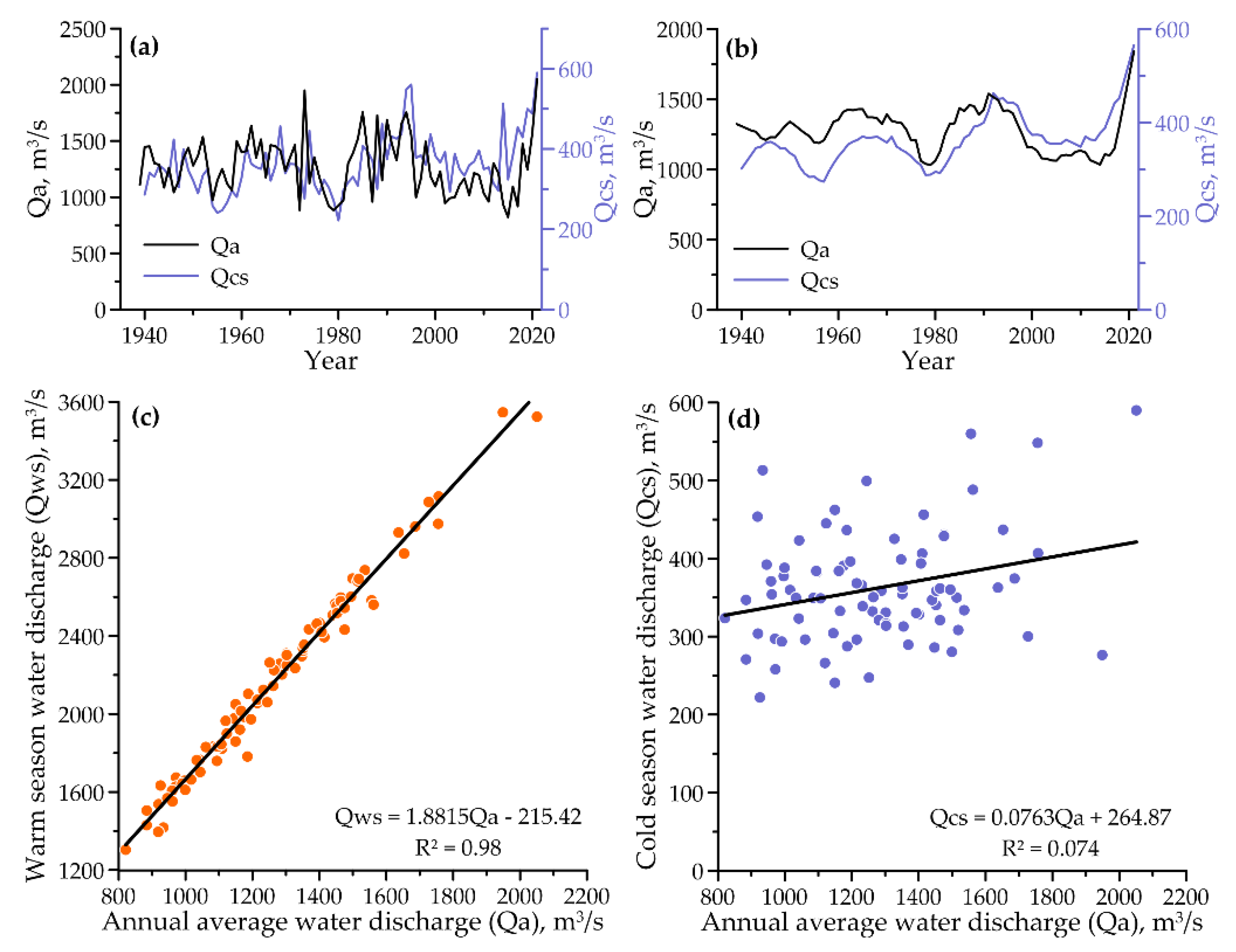

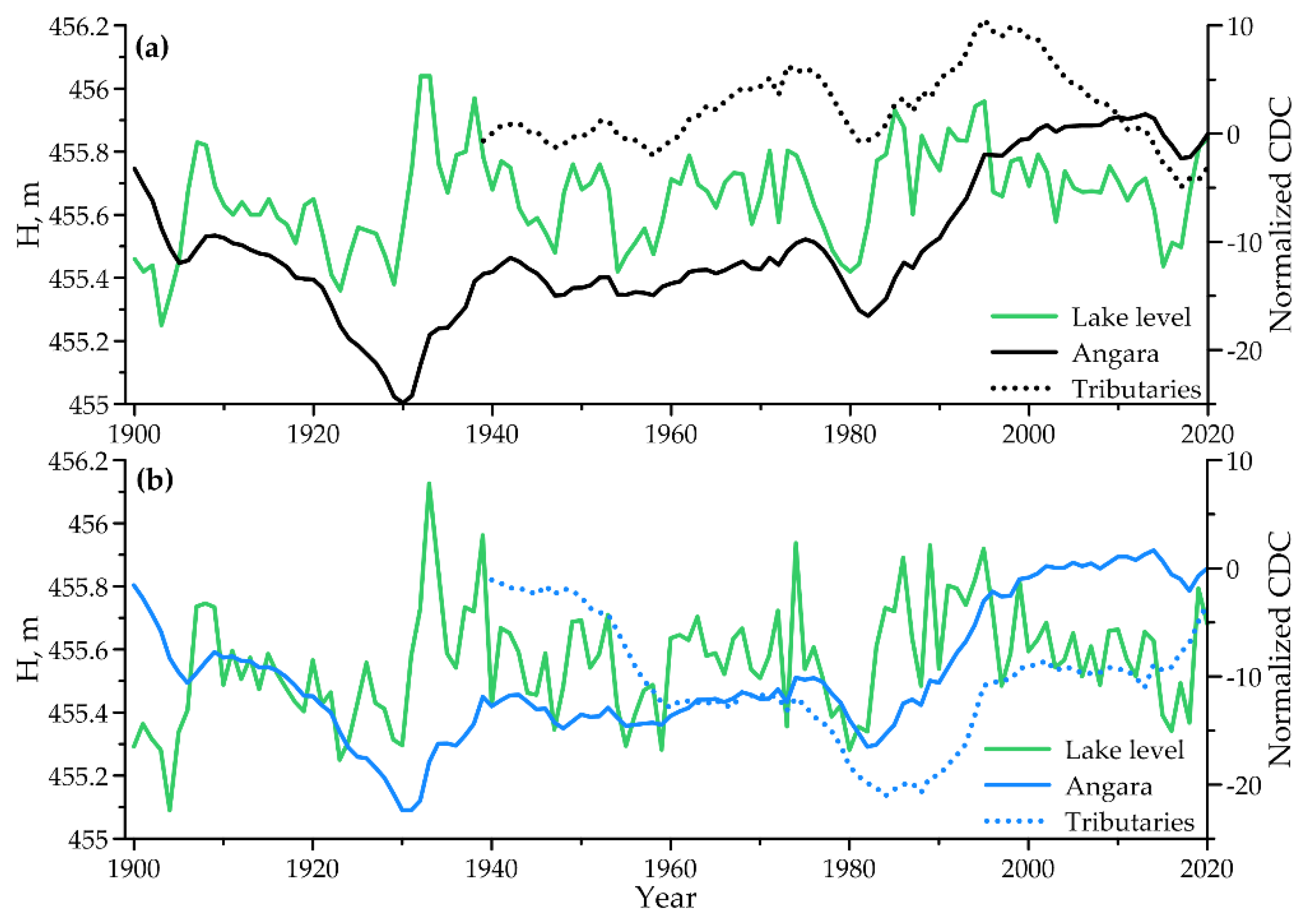
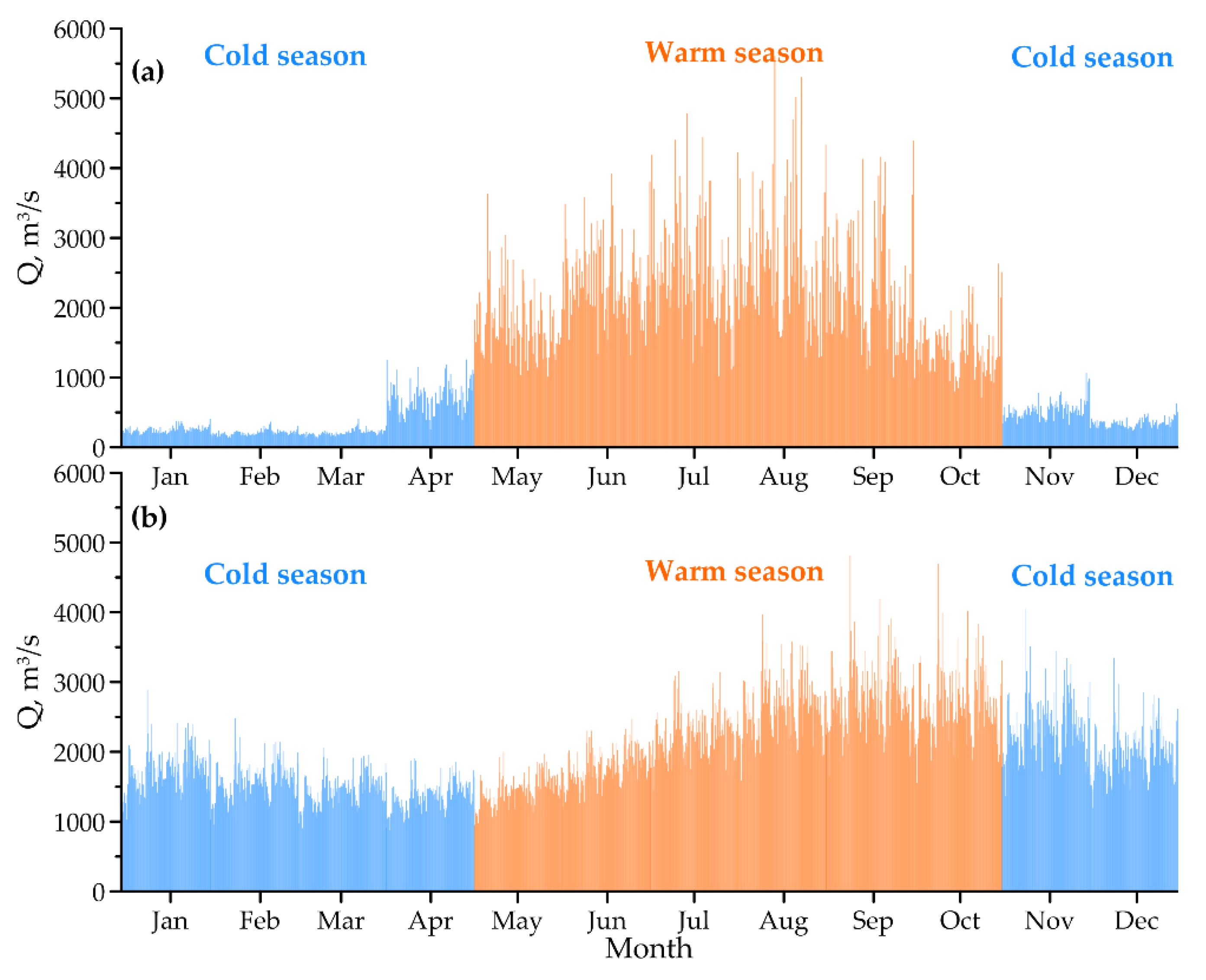


| Lake, River | Gauge Station | Basin Area, km2 | Period of Observations | Long-Term Conditionally Natural Annual Means |
|---|---|---|---|---|
| Baikal Lake | Baikal | 540,000 31,500 * | 1898–2020 | Level: 455.66 m, PHS Volume: 23,000 km3 |
| Angara River ** | Pashki Irkutsk HPP | 572,000 573,000 | 1898–1958 1959–2021 | Discharge: 2010 m3/s |
| Selenga River | Mostovoy | 440,000 | 1936–2021 | Discharge: 888 m3/s |
| Barguzin River | Barguzin | 19,800 | 1934–2021 | Discharge: 123 m3/s |
| Upper Angara River | Upper Zaimka | 20,600 | 1939–2021 | Discharge: 268 m3/s |
| Equation Number (k) | Predictors | Resulting Equation | Correlation Coefficient | s, cm | s/σ |
|---|---|---|---|---|---|
| 1 | Rin i | 0.0126Rin i + 454.89 | 0.86 | 8.4 | 0.52 |
| 2 | Rin i, Rin i−1 | 0.00911Rin i + 0.0077Rin i−1 + 454.65 | 0.97 | 3.6 | 0.23 |
| 3 | Pri | 0.0426Pri + 455.22 | 0.51 | 12.5 | 0.78 |
| 4 | Ei | 0.026Ei + 455.37 | 0.22 | 15.9 | 0.98 |
| 5 | Rin i, Pri, Ei | 0.0133Rin i − 0.0063Pri + 0.0097Ei + 453.83 | 0.86 | 8.4 | 0.51 |
| 6 | Rin′ | 0.0111Rin′ i + 454.98 | 0.84 | 8.8 | 0.54 |
| 7 | Rout i | 0.0154 Rout i + 454.69 | 0.98 | 3.2 | 0.20 |
| 8 | Rin i, Rout i | 0.0081Rin i + 0.0082Rout i + 454.60 | 0.98 | 3.0 | 0.19 |
| Parameters | Calendar Year | Warm Season | Cold Season |
|---|---|---|---|
| Highest level, m | 456.04 | 456.26 | 456.04 |
| Lowest level, m | 455.25 | 455.33 | 455.06 |
| Amplitude, m | 0.79 | 0.93 | 0.98 |
| Average value, m | 455.65 | 455.79 | 455.52 |
| Standard deviation, m | 0.15 | 0.17 | 0.17 |
| Total number of sub-series | 32 | 30 | 48 |
| Longest sub-series, years | 18 | 15 | 15 |
| Average length of sub-series, years | 3.84 | 4.10 | 2.54 |
| Probability of changing an increased value to an increased value | 0.77 | 0.77 | 0.63 |
| Probability of changing an increased value to a decreased value | 0.23 | 0.23 | 0.37 |
| Probability of changing a decreased value to a decreased value | 0.72 | 0.75 | 0.61 |
| Probability of changing a decreased value to an increased value | 0.28 | 0.25 | 0.39 |
| Correlation coefficient of adjacent values | 0.72 | 0.59 | 0.49 |
| Direction of Changes in Level | Period, Years/Change in Level, cm | |||
|---|---|---|---|---|
| Increase | 1903–1907/58 | 1929–1932/66 | 1980–1985/52 | 2016–2020/40 |
| Decrease | 1908–1929/47 | 1933–1947/46 | 1986–2015/49 | |
| No noticeable changes | 1948–1979 | |||
| Characteristics | Conditionally Natural | Regulated |
|---|---|---|
| Highest level, m PHS | 456.64 | 457.35 |
| Minimum level, m PHS | 455.08 | 455.31 |
| Average level, m PHS | 455.70 | 456.40 |
| Fluctuations range, m | 1.56 | 2.04 |
| Annual amplitude of fluctuations, m: | ||
| Average | 0.74 | 0.82 |
| Maximum | 1.49 | 1.62 |
| Minimum | 0.35 | 0.35 |
| Mean standard deviation, m | 0.30 | 0.39 |
| Correlation coefficient of adjacent months | 0.89 | 0.91 |
Disclaimer/Publisher’s Note: The statements, opinions and data contained in all publications are solely those of the individual author(s) and contributor(s) and not of MDPI and/or the editor(s). MDPI and/or the editor(s) disclaim responsibility for any injury to people or property resulting from any ideas, methods, instructions or products referred to in the content. |
© 2024 by the authors. Licensee MDPI, Basel, Switzerland. This article is an open access article distributed under the terms and conditions of the Creative Commons Attribution (CC BY) license (https://creativecommons.org/licenses/by/4.0/).
Share and Cite
Sinyukovich, V.N.; Georgiadi, A.G.; Groisman, P.Y.; Borodin, O.O.; Aslamov, I.A. The Variation in the Water Level of Lake Baikal and Its Relationship with the Inflow and Outflow. Water 2024, 16, 560. https://doi.org/10.3390/w16040560
Sinyukovich VN, Georgiadi AG, Groisman PY, Borodin OO, Aslamov IA. The Variation in the Water Level of Lake Baikal and Its Relationship with the Inflow and Outflow. Water. 2024; 16(4):560. https://doi.org/10.3390/w16040560
Chicago/Turabian StyleSinyukovich, Valery N., Aleksandr G. Georgiadi, Pavel Y. Groisman, Oleg O. Borodin, and Ilya A. Aslamov. 2024. "The Variation in the Water Level of Lake Baikal and Its Relationship with the Inflow and Outflow" Water 16, no. 4: 560. https://doi.org/10.3390/w16040560
APA StyleSinyukovich, V. N., Georgiadi, A. G., Groisman, P. Y., Borodin, O. O., & Aslamov, I. A. (2024). The Variation in the Water Level of Lake Baikal and Its Relationship with the Inflow and Outflow. Water, 16(4), 560. https://doi.org/10.3390/w16040560







